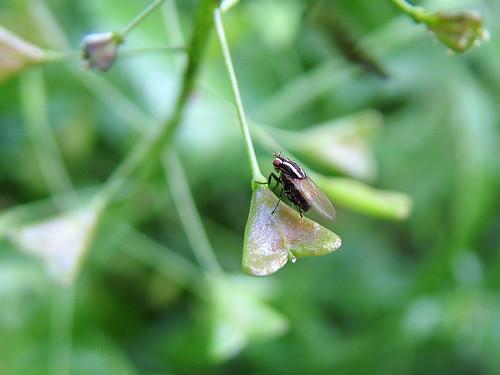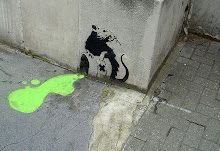Recently I realized my earlier post on edible carnivorous fungi and plants needs some further bulking up. Combined with the removal of the appropriate categories on Wikipedia, I figured I'd revisit, expound, and preserve the information here. The lists are by no means complete, so feel free to let me know what else is out there.
Also I'm including some vegan recipes. Well, vegan if you ignore what the plant ate. Some vegans think it's ok to eat them as it's 'natural.' Some think it's ok as they do not see a transitive property apply. Some eat them out of ignorance. Some do not eat them. There is no vegan rulebook.
Note that the definitions of 'edible' and 'carnivorous' are somewhat vague in some cases. 'Edible' could range from something that will not kill you if you eat it, to something palatable, to something commercially farmed for food. The applicable aphorism is that all plants and fungi are edible, sometimes more than once. In all cases it is anthropocentric, meaning edible to humans. Palatability has a wide range as well, but usually there is a balance to be found. Personally, as a fan of foraging, I don't think something has to be currently cultivated to count as edible, but it should be palatable. The cultivation angle is further fuzzy for these plants, as many are cultivated as ornamental plants and not for food. I also do not think that preparative steps that make a toxic plant edible (such as with cassava or acorns) should remove it from this list. Note that I am not including herbal medicines or any of that hooey. If it's good enough to truly heal, it's a medicine and not food.
'Carnivorous' typically fall short of Audrey II, but can range from active trapping of animals to a more passive external digestion. The prey animals range from vertebrates like mice and frogs to microscopic worms like nematodes. A few of the plants generally accepted as full carnivores do not have proteolytic enzymes, but let bacteria do that work for them. Others produce digestive enzymes but are considered merely protocarnivorous. Some plants have trapping mechanisms solely for defense but not to gain nutrients. To be considered a full carnivore, they need some kind of trap, and they need to absorb nutrients. In any event, there's probably something here that fits your specific definitions, and I'll try to specify where each plant or fungus is.
First, a partial list edible carnivorous plants:
 Capsella bursa-pastoris (shepherd's purse) -- I've eaten this wild from my yard and cultivated in frozen bao. Though it is at best protocarnivorous, seeming more to defend it's seeds with sticky mucilage and digestive enzymes than to feed itself. You can try it in an early spring salad or in a mung bean porridge.
Capsella bursa-pastoris (shepherd's purse) -- I've eaten this wild from my yard and cultivated in frozen bao. Though it is at best protocarnivorous, seeming more to defend it's seeds with sticky mucilage and digestive enzymes than to feed itself. You can try it in an early spring salad or in a mung bean porridge.- Dipsacus japonicus (Japanese teasel, Chinese teasel) and Dipsacus mitis (no common name) -- The teasel family are alleged protocarnivores. Leaves of D. mitis can be cooked and eaten. The same applies for D. japonicus, but only when nothing else is available to eat.
 Drosera capensis (Cape sundew), Drosera rotundifolia (common sundew, round-leaved sundew), and Drosera spatulata (spoon-leaved sundew) -- These three insectivorous species are used to make the German libation Sonnentau Likör. D. rotundifolia is used in Italy in the traditional recipe for rosolio. They are all full carnivores, and D. capensis even moves to surround prey in stickiness.
Drosera capensis (Cape sundew), Drosera rotundifolia (common sundew, round-leaved sundew), and Drosera spatulata (spoon-leaved sundew) -- These three insectivorous species are used to make the German libation Sonnentau Likör. D. rotundifolia is used in Italy in the traditional recipe for rosolio. They are all full carnivores, and D. capensis even moves to surround prey in stickiness. Drosera peltata subsp. auriculata (Climbing sundew) --This and the tubers of other sundews of Australia can be eaten and are foraged by the Aborigines. According to the Chinese government, D. peltata is "slightly toxic."
Drosera peltata subsp. auriculata (Climbing sundew) --This and the tubers of other sundews of Australia can be eaten and are foraged by the Aborigines. According to the Chinese government, D. peltata is "slightly toxic." Geranium viscosissimum (sticky purple geranium) -- The foraged leaves and flowers of this protocarnivore are used as a garnish or in salad.
Geranium viscosissimum (sticky purple geranium) -- The foraged leaves and flowers of this protocarnivore are used as a garnish or in salad.
 Nepenthes mirabilis (common swamp pitcher-plant) and likely other Nepenthes species -- The pitcher plants trap insects, mice, frogs, et cetera in the pitchers and digest them. In Malaysia the pitchers are cleaned and stuffed with sticky rice and coconut milk to make 猪笼草饭. Nepenthes are sold in public markets there for apparent culinary purposes.
Nepenthes mirabilis (common swamp pitcher-plant) and likely other Nepenthes species -- The pitcher plants trap insects, mice, frogs, et cetera in the pitchers and digest them. In Malaysia the pitchers are cleaned and stuffed with sticky rice and coconut milk to make 猪笼草饭. Nepenthes are sold in public markets there for apparent culinary purposes. Passiflora foetida (wild maracuja, santo papa, marya-marya) -- Another protocarnivore with stickiness and enzymes. Eat raw like any other passion fruit species, or make into jam or jelly.
Passiflora foetida (wild maracuja, santo papa, marya-marya) -- Another protocarnivore with stickiness and enzymes. Eat raw like any other passion fruit species, or make into jam or jelly. Pinguicula vulgaris (common butterwort) -- As you may expect from the common name, this has a dairy connection. The leaves are not ingested directly, but cow's milk is poured over the leaves to curdle it to make tjukkmjølk. This is just begging for someone to make a soy/almond/coconut version! Though the name is allegedly a PGI and cannot be used if it's made out of Roros, Norway, so you'll have to think up a generic name for the vegan version. Maybe leave out a K or something. Once you do that you can use one of these easily veganizable recipes. A similar product from Sweden called tätmjölk/filtäte/täte/långmjölk is prepared similarly and also fermented. You can try veganizing Linnaeus' original recipe.
Pinguicula vulgaris (common butterwort) -- As you may expect from the common name, this has a dairy connection. The leaves are not ingested directly, but cow's milk is poured over the leaves to curdle it to make tjukkmjølk. This is just begging for someone to make a soy/almond/coconut version! Though the name is allegedly a PGI and cannot be used if it's made out of Roros, Norway, so you'll have to think up a generic name for the vegan version. Maybe leave out a K or something. Once you do that you can use one of these easily veganizable recipes. A similar product from Sweden called tätmjölk/filtäte/täte/långmjölk is prepared similarly and also fermented. You can try veganizing Linnaeus' original recipe. Plumbago auriculata (blue plumbago, Cape plumbago, Cape leadwort) --Another protocarnivorous genus, but only this species is edible as far as I found. Try a plumbago and beetroot salad or vegetarianize/degelatinize this recipe for plumbago fruit jelly.
Plumbago auriculata (blue plumbago, Cape plumbago, Cape leadwort) --Another protocarnivorous genus, but only this species is edible as far as I found. Try a plumbago and beetroot salad or vegetarianize/degelatinize this recipe for plumbago fruit jelly.
 Proboscidea spp. (devil's claws, unicorn plants) -- a protocarnivorous (or perhaps merely murderous) genus of multiple (half-dozen or so) edible species. Mostly foraged. Some basic recipes and other culinary uses.
Proboscidea spp. (devil's claws, unicorn plants) -- a protocarnivorous (or perhaps merely murderous) genus of multiple (half-dozen or so) edible species. Mostly foraged. Some basic recipes and other culinary uses.- Stylidium vitiense (a kind of triggerplant) -- The fruit is edible. All plants in this genus are either a full carnivore or a protocarnivore, depending on your point of view. And speaking of views, I could not find a single image of this plant. If you find one, let me know.
Utricularia vulgaris (common bladderwort) -- an aquatic carnivorous plant, so you can check off three boxes with this guy. The leaves and root are eaten. The juice can be drunk, but I wonder if that means the digestive fluid in the bladders or what.
Now a partial list of edible carnivorous fungi:
 Coprinus comatus (shaggy mane, shaggy inky cap, lawyer's wig) -- A nematophagous fungus that traps, poisons, and kills its prey. It is cultivated in China and foraged in the West. Try it in a shaggy mane berbere or casserole.
Coprinus comatus (shaggy mane, shaggy inky cap, lawyer's wig) -- A nematophagous fungus that traps, poisons, and kills its prey. It is cultivated in China and foraged in the West. Try it in a shaggy mane berbere or casserole. Hohenbuehelia petaloides (no common name) -- Another musher that gets all BTK on the nematodes. Not a choice edible (described as mealy), and may be hyperallergenic, but you can eat it if you want to. Do you want to? If so, tell me some recipes.
Hohenbuehelia petaloides (no common name) -- Another musher that gets all BTK on the nematodes. Not a choice edible (described as mealy), and may be hyperallergenic, but you can eat it if you want to. Do you want to? If so, tell me some recipes. Laccaria bicolor (deceiver, xocoyule) -- Unlike the other fungi here, the awesomely named deceiver mushroom kills insects like springtails. They are a traditional food of the Nahua (Aztec) people of Mexico.
Laccaria bicolor (deceiver, xocoyule) -- Unlike the other fungi here, the awesomely named deceiver mushroom kills insects like springtails. They are a traditional food of the Nahua (Aztec) people of Mexico. Pleurotus spp. (oyster mushrooms, abalone mushrooms, tree mushrooms) -- I hate when one organism is named for another, but I imagine at least the mushroom was named after the mollusc chronologically as well. Anyway, all Pleuroti are nematophagous, having little loops that slowly tighten around the wee worms. Most of the 31 or so species are edible, and many are cultivated. I personally have eaten, bought, foraged, and grown a number of species. Try oysters Newburgh.
Pleurotus spp. (oyster mushrooms, abalone mushrooms, tree mushrooms) -- I hate when one organism is named for another, but I imagine at least the mushroom was named after the mollusc chronologically as well. Anyway, all Pleuroti are nematophagous, having little loops that slowly tighten around the wee worms. Most of the 31 or so species are edible, and many are cultivated. I personally have eaten, bought, foraged, and grown a number of species. Try oysters Newburgh.- Stropharia rugosoannulata (wine cap stropharia, garden giant, burgundy mushroom, king stropharia, Godzilla mushroom) -- Like the others, this big guy takes out nematodes. If it doesn't grow near you, you can plant it, and it will give help your other plants like maize and Super Marios as well as giving your yard that Alice-in-Wonderland look. Eat them spiced, in wine, or both, as you'll probably have plenty.








Awesome post - very informative. I'm not sure I'm up to the recipe challenge, but I'll certainly let you know if I do try any of these.
ReplyDeleteThey looks like from another planet ;)
ReplyDeleteSo pitcher plants are actually edible!
ReplyDelete